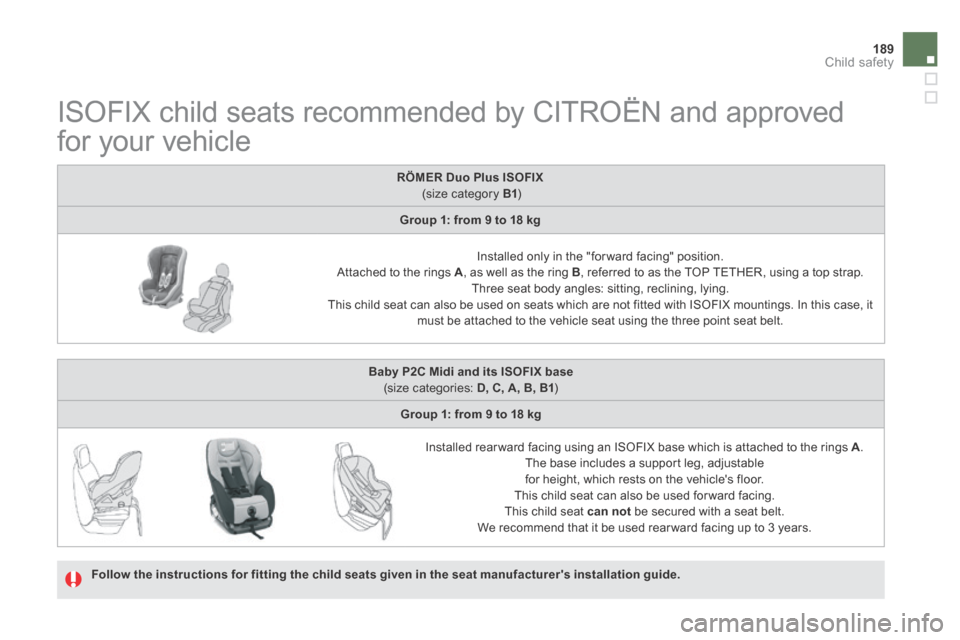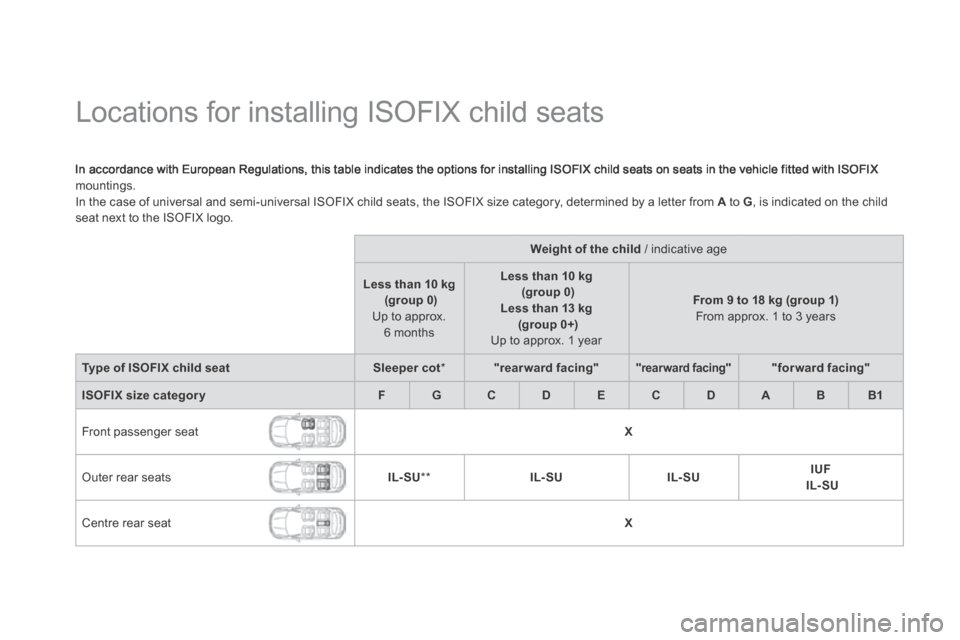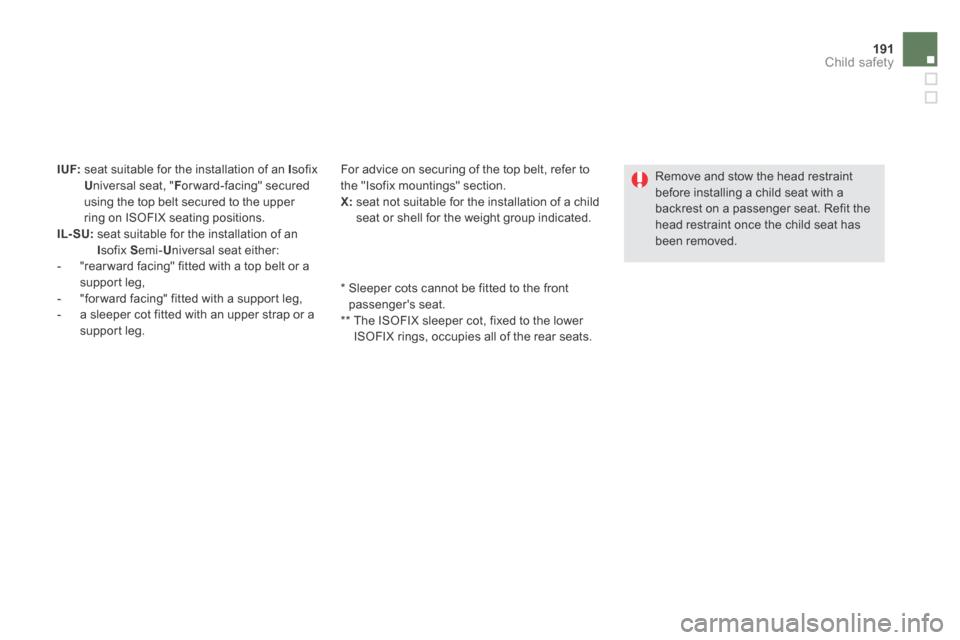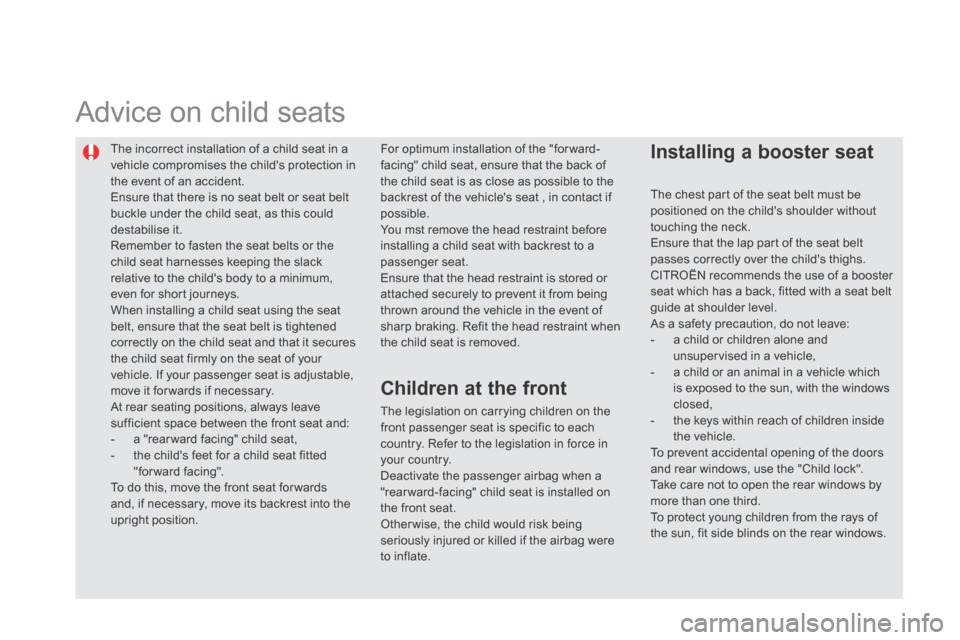Citroen DS5 HYBRID4 2014 1.G Owner's Manual
Manufacturer: CITROEN, Model Year: 2014, Model line: DS5 HYBRID4, Model: Citroen DS5 HYBRID4 2014 1.GPages: 380, PDF Size: 13.62 MB
Page 191 of 380

189Child safety
DS5-HYBRID_EN_CHAP06_SECURITE ENFANTS_ED02-2013
ISOFIX child seats recommended by CITROËN and approved
for your vehicle
Follow the instructions for fitting the child seats given in the seat manufacturer's installation guide.
RÖMER Duo Plus ISOFIX (size category B1 )
Group 1: from 9 to 18 kg
Installed only in the "for ward facing" position. Attached to the rings A , as well as the ring B , referred to as the TOP TETHER, using a top strap. Three seat body angles: sitting, reclining, lying. This child seat can also be used on seats which are not fitted with ISOFIX mountings. In this case, it must be attached to the vehicle seat using the three point seat belt.
Baby P2C Midi and its ISOFIX base (size categories: D, C, A, B, B1 )
Group 1: from 9 to 18 kg
Installed rear ward facing using an ISOFIX base which is attached to the rings A . The base includes a support leg, adjustable for height, which rests on the vehicle's floor. This child seat can also be used for ward facing. This child seat can not be secured with a seat belt. We recommend that it be used rear ward facing up to 3 years.
Page 192 of 380

DS5-HYBRID_EN_CHAP06_SECURITE ENFANTS_ED02-2013
Locations for installing ISOFIX child seats
In accordance with European Regulations, this table indicates the options for installing ISOFIX child seats on seats in the vehicle fitted with ISOFIX mountings. In the case of universal and semi-universal ISOFIX child seats, the ISOFIX size category, determined by a letter from A to G , is indicated on the child seat next to the ISOFIX logo.
Weight of the child / indicative age
Less than 10 kg (group 0) Up to approx. 6 months
Less than 10 kg (group 0) Less than 13 kg (group 0+) Up to approx. 1 year
From 9 to 18 kg (group 1) From approx. 1 to 3 years
Type of ISOFIX child seatSleeper cot * "rearward facing""rearward facing""forward facing"
ISOFIX size categor yFGCDECDABB1
Front passenger seat X
Outer rear seats IL- SU ** IL- SUIL- SUIUF IL- SU
Centre rear seat X
Page 193 of 380

191Child safety
DS5-HYBRID_EN_CHAP06_SECURITE ENFANTS_ED02-2013
I UF: seat suitable for the installation of an I sofix U niversal seat, " F or ward-facing" secured using the top belt secured to the upper ring on ISOFIX seating positions.
IL- SU: seat suitable for the installation of an I sofix S emi- U niversal seat either: - "rear ward facing" fitted with a top belt or a support leg, - "for ward facing" fitted with a support leg, - a sleeper cot fitted with an upper strap or a support leg.
* Sleeper cots cannot be fitted to the front passenger's seat. ** The ISOFIX sleeper cot, fixed to the lower ISOFIX rings, occupies all of the rear seats.
Remove and stow the head restraint before installing a child seat with a backrest on a passenger seat. Refit the head restraint once the child seat has been removed.
For advice on securing of the top belt, refer to the "Isofix mountings" section. X: seat not suitable for the installation of a child seat or shell for the weight group indicated.
Page 194 of 380

DS5-HYBRID_EN_CHAP06_SECURITE ENFANTS_ED02-2013
The incorrect installation of a child seat in a vehicle compromises the child's protection in the event of an accident. Ensure that there is no seat belt or seat belt buckle under the child seat, as this could
destabilise it. Remember to fasten the seat belts or the child seat harnesses keeping the slack relative to the child's body to a minimum, even for short journeys. When installing a child seat using the seat belt, ensure that the seat belt is tightened correctly on the child seat and that it secures the child seat firmly on the seat of your vehicle. If your passenger seat is adjustable, move it for wards if necessary. At rear seating positions, always leave sufficient space between the front seat and: - a "rear ward facing" child seat, - the child's feet for a child seat fitted "forward facing". To do this, move the front seat for wards and, if necessary, move its backrest into the upright position.
Advice on child seats
Installing a booster seat
The chest part of the seat belt must be positioned on the child's shoulder without
touching the neck. Ensure that the lap part of the seat belt passes correctly over the child's thighs. CITROËN recommends the use of a booster seat which has a back, fitted with a seat belt guide at shoulder level. As a safety precaution, do not leave: - a child or children alone and unsupervised in a vehicle, - a child or an animal in a vehicle which is exposed to the sun, with the windows closed, - the keys within reach of children inside the vehicle. To prevent accidental opening of the doors and rear windows, use the "Child lock". Take care not to open the rear windows by more than one third. To protect young children from the rays of the sun, fit side blinds on the rear windows.
The legislation on carrying children on the front passenger seat is specific to each country. Refer to the legislation in force in your country. Deactivate the passenger airbag when a "rear ward-facing" child seat is installed on the front seat. Otherwise, the child would risk being seriously injured or killed if the airbag were to inflate.
Children at the front
For optimum installation of the "forward-facing" child seat, ensure that the back of the child seat is as close as possible to the backrest of the vehicle's seat , in contact if possible.
You mst remove the head restraint before installing a child seat with backrest to a passenger seat. Ensure that the head restraint is stored or attached securely to prevent it from being thrown around the vehicle in the event of sharp braking. Refit the head restraint when the child seat is removed.
Page 195 of 380

193Child safety
DS5-HYBRID_EN_CHAP06_SECURITE ENFANTS_ED02-2013
Electric child lock
Remote control system to prevent opening of the rear doors using their interior controls and use of the rear electric windows.
Switching on Switching off
Any other status of the indicator lamp indicates a fault with the electric child lock. Have it checked by a CITROËN dealer or a qualified workshop.
This system is independent and in no circumstances does it take the place of the central locking control. Check the status of the child lock each time you switch on the ignition. Always remove the key from the ignition when leaving the vehicle, even for a short time. In the event of a serious impact, the
electric child lock is switched off automatically to permit the exit of the rear passengers.
With the ignition on, press this button. With the ignition on, press this button again.
The indicator lamp in the button comes on, accompanied by a message to confirm that the child lock is on. This indicator lamp remains on until the child lock is switched off. It is still possible to open the doors from the outside and operate the rear electric windows from the driver's control panel.
The indicator lamp in the button goes off, accompanied by a message to confirm that the child lock is off. This indicator lamp remains off while the child lock is switched off.
Page 196 of 380

Safety
Page 197 of 380

DS5-HYBRID_EN_CHAP07_SECURITE_ED02-2013
Page 198 of 380

Direction indicators
Lower the lighting control stalk fully when moving to the left. Raise the lighting control stalk fully when moving to the right.
Three fl ashes
Move the stalk briefly upwards or downwards, without going beyond the point of resistance; the corresponding direction indicators will flash 3 times.
If you forget to cancel the direction indicators for more than twenty seconds, the volume of the audible signal will increase if the speed is above 40 mph (60 km/h).
Hazard warning lamps
Press the button, the direction indicators flash. They can operate with the ignition off.
Automatic operation of
hazard warning lamps
When braking in an emergency, depending on the rate of deceleration, as well as when the ABS regulation is invoked or in the event of an impact, the hazard warning lamps come on automatically. They switch off automatically the first time you accelerate. You can also switch them off by pressing
the button.
This function can be used at any speed, but it is particularly useful for changing lane on fast roads.
Page 199 of 380

197Safety
DS5-HYBRID_EN_CHAP07_SECURITE_ED02-2013
Horn
Emergency or
assistance call
This system allows you to make an emergency or assistance call to the emergency services or to the dedicated CITROËN service.
Audible warning system to alert other road users to an imminent danger.
Press the central part of the multifunction
steering wheel.
Use the horn moderately and only in the following circumstances: - immediate danger, - overtaking a cyclist or pedestrian, - approaching a location lacking visibility.
For more information on the use of this function, refer to the "Audio and telematics" section.
Page 200 of 380

A set of the following Electronic Stability systems: - anti-lock braking system (ABS) and electronic brake force distribution (EBFD), - emergency braking assistance, - wheel anti-slip regulation (ASR) or traction control, - dynamic stability control (DSC).
Electronic stability control (ESC)
Definitions
Anti-lock braking system (ABS) and electronic brake force distribution (EBFD)
This system improves the stability and manoeuvrability of your vehicle when braking and provides improved control in corners, in particular on poor or slippery road sur faces. The ABS prevents wheel lock in the event of emergency braking. The electronic brake force distribution system manages the braking pressure wheel by wheel.
Emergency braking assistance
In an emergency, this system enables you to reach the optimum braking pressure more quickly and therefore reduce the stopping distance. It is triggered in relation to the speed at which the brake pedal is pressed. This is felt by a reduction in the resistance of the pedal and an increase in the effectiveness of the braking.
Anti-slip regulation (ASR)
The ASR system (also known as Traction Control) optimises traction in order to avoid wheel slip by acting on the brakes of the driving wheels and on the engine. It also improves the directional stability of the vehicle on acceleration.
Dynamic stability control (DSC)
If there is a difference between the path followed by the vehicle and that required by the driver, the DSC monitors each wheel and automatically acts on the brake of one or more wheels and on the engine to return the vehicle to the required path, within the limits of the laws of physics.